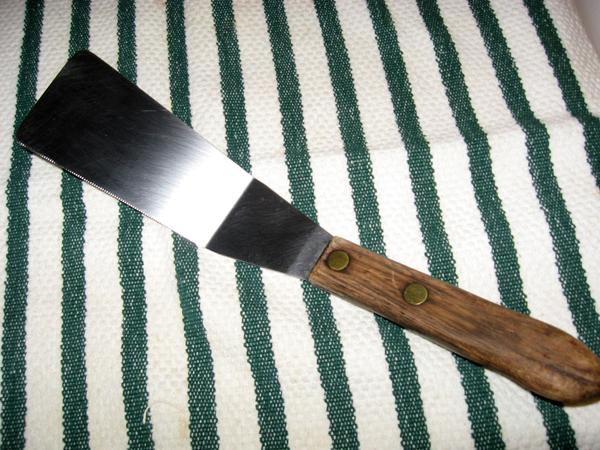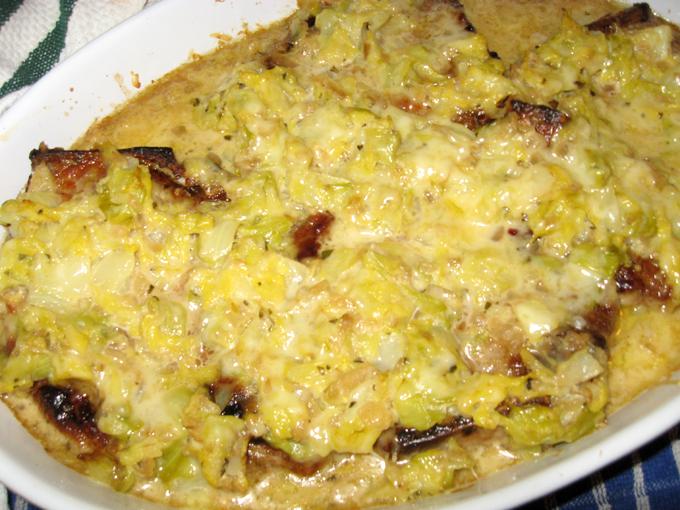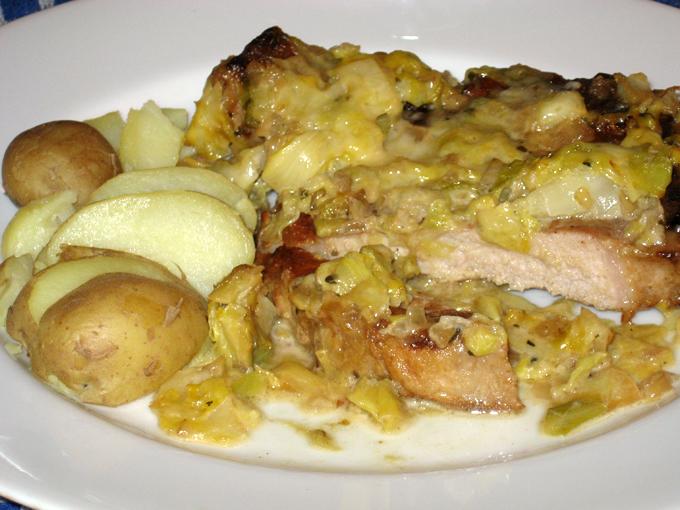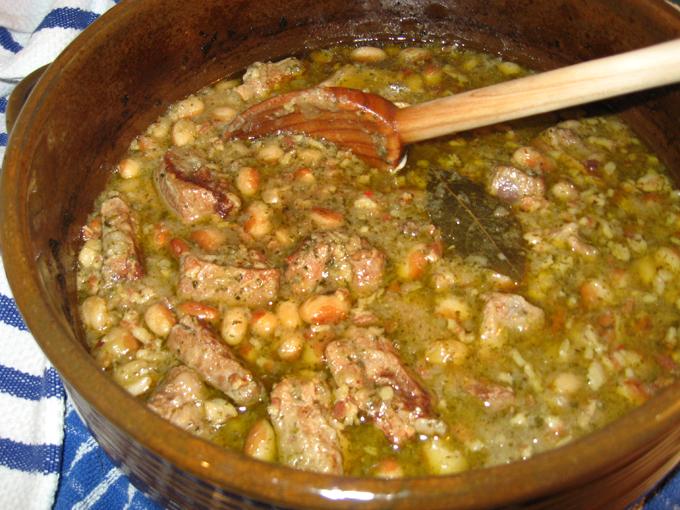-
Posts
1,729 -
Joined
-
Last visited
Content Type
Profiles
Forums
Store
Help Articles
Everything posted by djyee100
-
A surprising number of dishes, even though they are cooked over an hour in the oven, require some kind of tending now and then. I'm curious, why the interest in something that you can neglect in the oven and serve right away? Are you about to cook a dinner for multitudes, all by yourself? - Just about any kind of potato gratin cooks in the oven for an hour, unattended. - Sartu, a Neapolitan variation on lasagna, is a meal-in-one dish--layers of meatballs, tomato sauce, mushrooms, chicken livers, peas, boiled eggs, and mozzarella cheese, in a rice crust. It's rich and yummy, and I'm starting to think it's time for me to cook this one again. I like Joyce Goldstein's recipe in her cookbook, Italian Slow and Savory. The recipe is available on Googlebooks, Page 109. http://books.google.com/books?id=uaJXsT3y6qUC&printsec=frontcover&dq=joyce+goldstein&cd=10#v=onepage&q=sartu&f=false - Another possibility, also Italian. (Are these grandmother's recipes for cooking in the oven while the family goes to Mass?) Chicken in Bread (Pollo in Pane), a chicken stuffed with chicken livers and vegetables, wrapped in bread dough, then baked. The dish comes to the table as a big golden bread dome. You cut off the top and serve some chicken with stuffing and a chunk of bread, which has absorbed the juices during cooking. http://www.bigoven.com/132590-Pollo-in-Pane-recipe.html I haven't cooked this particular recipe, but it's close to the one I used to make. I suggest adding some fresh chopped rosemary, thyme and /or sage to the mirepoix. An egg wash on the dough before baking will make a showy, golden brown bread dome. I cooked my pollo in pane for 1 1/2 hrs in a 375 degree oven, and let it rest for about 30 mins before serving. The recipe doesn't give you the bread dough recipe, so try this one. Bread Dough: Dissolve 1 TB active dry yeast and a pinch of sugar in 1/2 cup of warm water. Then combine the yeast in a bowl with 1 1/2 lbs (approx 5 cups) of unbleached white flour, 2 tsp salt, and about 1 1/2 cups of warm water to form a soft dough. Knead until the dough is smooth and shiny. Place in an oiled bowl, cover, and let rise until doubled in bulk, about 1 1/2 hours. Deflate the dough, and use as directed in the recipe. Yields about 2 lbs of bread dough.
-
Hmm...is this cabbage more like bok choy rather than Chinese or napa cabbage? The Chinese cabbage I'm thinking of is a pale green with very tender, wrinkly leaves. The tenderness can be important in recipes that include Chinese cabbage. Anyway, here are my ideas. I've never made this particular recipe, but it's similar to a Chinese cabbage salad I was addicted to for awhile. I like it with the addition of chopped cilantro and peanuts. James Peterson's Thai Chinese Cabbage Salad: http://www.epicurious.com/recipes/food/views/Thai-Chinese-Cabbage-Salad-15312 You could also make pork siu mai, one of the simplest of the Chinese dim sum. I like Joyce Jue's recipe. http://www.sfgate.com/cgi-bin/article.cgi?f=/c/a/1995/09/27/FD23330.DTL Potstickers can also contain some chopped Chinese cabbage. Actually, Chinese cabbage pairs well with any kind of Asian-style braised or steamed pork. I steam the cabbage and serve it as a veggie side dish. It also tastes good in an Asian-style soup with pork broth and pork meatballs. For a Western slant, Chinese cabbage tastes surprisingly good when sauteed with butter, S&P, and served with grilled meat.
-
I think it's hard for waitstaff to figure out what the customer preference may be sometimes. That secluded 4-seater in the corner was unattractive for you, but maybe the waitstaff thought you wouldn't like being in the middle of a large empty dining room. Some people don't like that. Really, just ask for a table that you want. The waitstaff will accommodate you if they can.
-
My two cents. It depends on how much milk you use. On hot cereal, I like only a small amount of milk on the grain to lighten the mixture. I would call the milk a sauce. On cold cereal (which I loathe & eat only under duress), I put in lots of milk, and plenty of sugar too. If there's fruit, I dump some of that on top. Then I take a few bites, mostly of fruit, and leave it. When all is said and done, I would call that concoction a cold soup.
-
Kasma's recipe for kanom krok, which you can make in an aebleskiver pan. It's supposed to yield 20-24 hotcakes. You should be able to halve the recipe. Also, (my advice) don't underestimate how many of these delicious little things you can eat. http://www.thaifoodandtravel.com/recipes/kanomkrok.html Some notes from the class where we made kanom krok: - if you use the dried unsweetened coconut, add about 1/4 cup water to lighten the batter. - stir the rice batter every time before you pour; it tends to settle. - fill the cups about 2/3 full (rather than 3/4); remember the aebleskiver pan is deeper than a Thai kanom krok pan. The kanom krok with green onions were the surprise favorite of the class.
-

Hummus: Additives, Techniques, Recipes
djyee100 replied to a topic in Middle East & Africa: Cooking & Baking
My apologies in advance to any purists on this thread. I've always liked Linda Carucci's California-style Hummus. It contains soy sauce and Worcestershire sauce, & it's zippier than classic hummus. The recipe is here: http://www.lckitchen.com/recipes.html#hummus I like hummus in a whole wheat bread sandwich with lettuce, tomato, cucumber, and maybe a tiny bit of red onion. ETA: Some crumbled feta cheese on that hummus sandwich tastes good too. Now I'm starting to feel hungry. -
I bought a cast iron aebleskiver pan years ago, and I made aebleskivers exactly once. They're delicious, but fussy. Recipes frequently require whipped egg whites, so it's not a simple pancake batter. My Thai cooking teacher, Kasma Loha-Unchit, uses her aebleskiver pan for cooking Thai coconut hotcakes, or kanom krok. The pan is good for that, although the cups are a little deeper than a Thai kanom krok pan. She also fries quail eggs in those little cups for a dainty brunch item. Again, not things one will cook everyday.
-
The only reference I've encountered for coffee with egg is Norwegian in origin, not Hungarian. But I bet both groups put egg in the coffee for the same reason. Carrie Young, in a wonderful article she wrote in Gourmet (March 1983, yes, that long ago) described her Norwegian mother's coffee, which included a whole egg. Her parents were homesteaders in North Dakota in the first years of the 20th century. Her memory of coffee and snacks for the threshing crew at harvest time: In her memoir of family and food, Prairie Cooks, Carrie Young again mentions coffee with egg. The egg was supposed to soften the water and make the coffee clear. The book, which is a pleasurable read, is available on Amazon. Also about Scandinavian egg drop coffee: http://www.baristaconnection.com/profiles/blog/show?id=1992125%3ABlogPost%3A6197
-
You could also take the BART subway to 16th Street Mission or 24th Street Mission. The BART ride might be easier with kids. (A fast ride, cleaner, better chance of finding seats.) The MUNI buses are slower and sometimes crowded, though when I'm in SF, I take MUNI to watch people and the street scene.
-
Ok, I'll give it a try. Daniel Webster?
-
A stainless steel spatula with a rosewood handle, a wedding gift to my mother. It was made in America circa 1950, nothing special at the time, but it's still good to use. I remember learning how to fry eggs with this spatula when I was a kid. Then I acquired it during my college years when I foraged in my parents' house for things to furnish my own apt. I think my mother gave me permission to take it.
-
I have no idea what this is. But I went snooping around the web, as I like to do. From a Googlebooks search, a phrase from La vie secrète de la cour de Chine By Albert Maybon: "restaurants où les mets rares sont servis en musique, comme au « Temple du Bonheur céleste »..." The Googlebook snippet leaves you hanging right there. For what it's worth, the Google translation: "restaurants where meals few have used music like the "Temple of Heavenly Happiness." http://books.google.com/books?lr=&cd=2&as_brr=0&q=%22Temple+du+Bonheur%22+food&btnG=Search+Books A reference also to an Alain Resnais movie, in which the Temple du Bonheur was a fanciful palace on a theatre stage. http://www.hellomovies.com/movie/la-vie-est-un-roman Depending on the context of your menu , a dessert shaped like a sugar and pastry palace?
-
High quality olive oils, vinegars, mustards, vanilla extract, and maple syrup. Put a star next to the pure maple syrup, which is delicious and which will take a chunk out of your gift certificates. It sounds like you're up to here in cookware, but in case you're not, W-S has some very useful All-Clad items on sale at a big discount. 4 qt saute pan: http://www.williams-sonoma.com/products/all-clad-d5-stainless-steel-4-quart-saute-simmer-pan/?pkey=ccookware-all-clad%7Cckwallbst 10- and 12-inch nonstick skillet: http://www.williams-sonoma.com/products/all-clad-d5-stainless-steel-nonstick-covered-fry-pan/?pkey=ccookware-all-clad%7Cckwallbst Funny, I thought about the ice cream maker too. The one with the built-in freezer unit. http://www.williams-sonoma.com/products/cuisinart-supreme-electric-ice-cream-maker/?pkey=x%7C4%7C1%7C%7C4%7Cice%20cream%20maker%7C%7C0&cm_src=SCH
-
How well I know that Piles of Plastic Bags on a shelf system. Then you have to sort through all those bags to find the ingredient you want. One day I got so frustrated with this system (non-system?) I impulsively bought all the containers I needed at the Container Store, where the prices are at a premium. (A few days later I was back at the store for something else, and the sales clerk said to me, "I remember you from the other day. You looked like you were on a mission.") If I had to do it all over again, I would go shopping online, like this place: http://www.usplastic.com/catalog/default.aspx?catid=691&parentcatid=845&gclid=CLjMhOeP0qACFQEBiQodeREUzQ For labels I use pieces of masking tape and a pen. Not fancy, but it's cheap and it works for me.
-
djyee -- that casserole looks so good it nearly makes me want to cry! Can you share the recipe? Em Don't cry, Emily_R! I'm glad to share the recipe. Porthos, the secret to this dish is to cook the cabbage in cream. If you cook cabbage in cream, that will mellow out the cabbage and not produce the boiled cabbage smell that bothers people. Milk also works for cooking cabbage, not just cream, but for a good sauce in this recipe, use cream. I learned to make this dish from Josette King, the daughter of a French hotel chef who taught a French cooking class in the basement of the Boston YWCA in the mid 1970s. Yes, I've been cooking this dish that long. Pork Chops in the Style of Auvergne (Cotes de Porc a l'Auvergnate) 1 medium-size cabbage 1/2 cup heavy cream salt & pepper 1 TB butter 4 large pork chops 1 cup chopped onion 1/2 tsp dried or 1 tsp freshly chopped sage 3/4 cup dry white wine 1/4 cup shredded Gruyere or Swiss cheese Quarter and core the cabbage. Blanche well in a pot of boiling water until the cabbage is just tender. Drain well and let cool somewhat. Dice or chop coarsely. Place the cabbage in a heavy saucepan, stir in the cream, add S & P, and bring to a simmer. Let simmer for 30 mins over low heat, stirring occasionally. Meanwhile, heat the butter in a skillet and fry the pork chops until golden brown and fully cooked. Remove from skillet and keep warm. Add the onion and sage to the skillet, and cook over moderate heat until the onion is golden and very tender. Raise the heat to high and add the wine, scraping any brown bits in the pan. Reduce the liquid to about one-half. When the cabbage is done, pour the liquid in the skillet over the cabbage. Combine well. Taste and adjust for salt. To assemble the casserole: Preheat oven to 325 degrees. Lightly butter a shallow baking dish. Spread half the cabbage in the dish, add the pork chops in a single layer, then cover with the remaining cabbage. Pour any liquid or juices over all. Sprinkle with cheese. Bake for about 20 mins, until the casserole is heated through and the cheese is melted. Serve immediately.
-
Delicious looking pizzas, Robirdstx. A Sunday dinner here of Pork Chops in the Style of Auvergne (Cotes de Porc a l'Auvergnate). This is a casserole of sauteed pork chops and braised cabbage in a sauce of sage, onion, white wine, and cream, topped with Gruyere cheese. A traditional dish from south-central France. Just out of the oven. Served with steamed potatoes.
-
A hearty dinner soup, Piedmontese Bean Soup with Spareribs from Paula Wolfert's Mediterranean Claypot Cooking. This soup is rich with pancetta, pork spareribs, beans, garlic, onions, parmesan cheese, and fresh herbs like sage, rosemary, and marjoram. Some dried red pepper and cinnamon give the soup a spicy kick, too. A pig's foot was supposed to go into the mix, but there was no time for extra shopping, so I omitted it. This soup tasted delicious without it. Served with plenty of crusty French bread, and for dessert, some sweet and refreshing Murcott tangerines. ETA: The beans are a bicolor variety from Rancho Gordo called Yellow Eye.
-
Are legumes included in starches? Right off the top of my head, people should know that if you add any starch to a dish (like soup), the starch will thicken the texture and also dull the flavors. People are often confused by all the different wheat flours out there: AP (the different brands have various protein amts), whole wheat, bread, pastry, cake, self-rising flour, bleached, unbleached...help! So some clarification there would probably be welcome. People should know why the levels of protein in these flours make a difference in what you're cooking. You could also demo yeast bread and pie crust, two starch-related foods that are frequent sources of cooking misery. The science behind the no-knead breads (superhydration of starches over time) might be worth discussing, too. Harold McGee's explanation appeared in the NY Times, along with Jim Lahey's no-knead bread recipe (which I regard as the best of the no-knead breads). http://www.nytimes.com/2006/11/08/dining/08mini.html?_r=1 ) People often find cooking these starchy dishes problematic: steamed rice, risotto, and couscous. Beginners could also use some pointers about cooking pasta al dente. For people with issues about steamed rice, I always suggest Kasma Loha-Unchit's method here: http://www.thaifoodandtravel.com/recipes/jasrice.html As for couscous, people want light, fluffy couscous and end up with something heavy and tough. They're usually following the instructions on the package. I always tell them about Paula Wolfert's method for cooking couscous, multiple steamings interspersed with sprinklings of water. Wolfert's method is more time-consuming, but the couscous piles up higher and lighter with each steaming, really beautiful. The method to cook couscous is included in Wolfert's recipe for fresh couscous, available on her website. This cooking method is fine for the dried couscous that you buy in supermarkets. **But if you're using dried couscous, first rinse it in a fine sieve, then dump it in a bowl, breaking up any lumps. Let stand for 10 mins. Then proceed with steaming as in the recipe, Step #4.** http://www.paula-wolfert.com/recipes/roll_your_own_couscous.html I cook my couscous in the shallow tray of this "multi-cooker." Any steamer pot like this will do the trick for the recipe. http://www.surlatable.com/product/all-clad+multi-cooker%2C+4-piece.do?keyword=all+clad+spaghetti+pot&sortby=ourPicks
-
Project, Many excellent comments already made about your recipe, & I have only a few things to add. If your dish overall seemed dull in flavor, and you couldn't taste all the good ingredients you put into it, that probably means you needed more salt. If the dish tasted flat or flabby, that means you needed to balance the fat in the dish with more of an acidic ingredient. I agree with others about adding more salt before the end, but be careful. The blood in the meat is already salty. While cooking, I salt lightly after adding each layer of flavor, then I taste and adjust for salt at the end. In your recipe, for example, I would salt lightly while sauteing the onions, then again while browning the beef, then again when adding the garlic, tomato sauce, and spices. What are you aiming to taste in this dish? I'll assume a rich, beefy piece of meat enhanced by aromatics, some cooked vegs, and a tasty broth. Your traditional aromatics of garlic, onions, carrots, celery, & bay leaves are on target, and the red wine and chicken stock will add depth to the broth. To add complexity to this mix, you could substitute a little brandy for some of the wine; or a little anise-flavored liquor would go well with beef and give it a Mediterranean touch. You could substitute a little butter for some olive oil for another flavor (butter enhances food wonderfully, and it doesn't take much). More herbs, like thyme and parsley, will add flavors too. If you chop and saute a strip of bacon with the onions, you'll add a smoky note and a different meat flavor to the dish. When making braised beef, my go-to wine is a red Rhone, sometimes a Beaujolais. I'm only looking for something fruity, without too much tannins or other off flavors. For cooking I buy young, drinkable wines that aren't meant to be cellared. I can't remember the last time I cooked with a cab, and I rarely cook with a burgundy. If the wine is very good, it really should be drunk at the table. If the wine is bad--and cabs and burgundies can age erratically--it shouldn't go into the pot. When I'm feeling motivated, I drain the vegs from the braised beef, puree them, then add some puree back to the sauce. Before the end of cooking time, I add fresh carrots, celery, or other vegs to the pot, let them cook until they are well done, and serve those vegs at the table. (I don't add potatoes, though. The starches dull the sauce.) The vegs you eat at the table have more flavor and firmness that way, not to mention a better appearance. I wondered about the amount of garlic and tomato sauce you put into the recipe. That's a lot of garlic, but you know yourself best. For this amt of meat, I would normally add 3 or 4 cloves of garlic. I would also add less tomato sauce, because tomatoes are a strong flavor that can take over the mix. Maybe the equivalent of 1-2 TB of tomato paste? Remember, these flavors are supposed to enhance the meat, not overwhelm it. Pot roast is supposed to be homey comfort food, rich-tasting but not really exciting. If you want to brighten it, don't mess with the dish itself, but think about an accompaniment at the table, like horseradish, mustard, port wine jelly, or (my favorite) a gremolata of parsley & lemon zest, that will make the dish more zingy. good luck with your recipe development!
-
The people in the article are making choices about spending their limited food dollars that are not the perceived norms for poor people. (Think about that one for awhile.) They're buying foods that many families regard as unaffordable, and that nettles their critics. The question in my mind is, what kind of food are food stamp recipients supposed to be buying, anyway? The public policy underlying food stamps isn't really cockeyed. These recipients are buying good food for their mental and physical health, and that should put them in a better position to find and keep new jobs. Also, these particular food stamp recipients are doing some skillful cooking. Cooking from raw ingredients stretches the food dollars. Their labor is part of the equation of why they're eating so well, but their critics don't seem to recognize that. I would also guess, although the article doesn't say, that if these people are buying expensive ingredients on a limited budget, they aren't exactly serving or eating humungous portions, either. The article mentions a monthly food allowance of $150-$200 for a single individual. If that were my food budget, I'd either be buying a fair amount of conventional vegetables and meat, and eating three meals a day, or I'd be buying smaller quantities of organic vegetables and meat, and eating maybe one good meal a day. Any other thoughts?
-
Is he planning to bring his own ham and cheese sandwich into a restaurant, and ask them to give him a plate? If his bill passes, plates may be the only thing a restaurant will be able to serve. From the NY Times, an article about the uncertain nature of salt research: http://www.nytimes.com/2010/02/23/science/23tier.html
-

When a Cake or Pastry recipe does not specify a type of flour, what do
djyee100 replied to a topic in Pastry & Baking
Really? That's interesting. I've never thought to try anything other than all-purpose (unless otherwise specified). I've always assumed that flours named the same would be the same across the border. I agree with Mkayahara. When I was baking from a cookbook by two Canadian authors, I encountered failure after failure. One day, as I gazed at a gooey puddle in my KitchenAid bowl, which the authors said should have been a firm dough, I realized that their flour must simply have more protein in it to absorb water. In this situation, I was using all-purpose flour, when a bread flour probably would have been better. Not all brands of all-purpose flours have the same amt of protein, although they're in the ballpark. King Arthur AP, for example, has slightly more protein (around 1% more) than Gold Medal AP. White Lily AP flour, a Southern flour, has even less protein, and is sometimes considered a pastry flour despite its label. If a recipe only says flour, I use AP flour, preferably Gold Medal AP, which results in more tender baked goods than King Arthur AP. I use King Arthur bread flour for breads, though. -
Big Brother seems to have moved into the kitchen. Before the state assembly & senate pass this bill, every supporter of this bill should eat no food with salt for a month, & see how they like it. "No owner or operator of a restaurant in this state shall use salt in any form in the preparation of any food for consumption by customers of such restaurant..." Goodbye, MacDonald's, Taco Bell, & other fast food chains. Goodbye to any restaurant that uses canned or frozen foods that have salt in them. Goodbye to any restaurant that uses salted artisanal foods like homemade pickles or pancetta. Even Chez Panisse couldn't survive these restrictions. "Whenever the court shall determine that a violation of this section has occurred, the court may impose a civil penalty of not more than one thousand dollars for each violation. Each use of salt in violation of this section shall constitute a separate violation." A restaurant can be fined up to $1000 for sprinkling some salt into a pot of soup. Sprinkle some salt into a second pot of soup, & that's $2000. The Attorney General's office is directed by this bill to bring these salt scofflaws to justice. Given their workload prosecuting serious criminals, I bet the AG's office just loves this bill. Legislation starts moving because interested parties (read: lobbyists) approach legislators with a proposal for a bill. More often than not, the legislators will put forward a bill because it has been suggested by a group towards whom they feel favorably inclined (read: campaign contributors). My question is: who in the world would want a bill like this, & why? And how did they get some legislators to go along? Personally, I doubt if this bill as written will go anywhere. But I've been wrong before. In the 1990s the California legislature passed a law forbidding the use of raw eggs in restaurant food. The law was aimed at sloppy restaurants. But it also affected the restaurants that use these ingredients responsibly. The law received many complaints (no more homemade mayonnaise or Caesar salad dressing at some top restaurants), and it was amended quickly to allow raw or undercooked eggs with the consent of the customers.
-
Julia's classic spinach souffle recipe mentions "other vegetable souffles" towards the end of the recipe, such as a souffle with finely diced or pureed asparagus tips. http://www.cookstr.com/recipes/spinach-souffle For a variation on the classic souffle, I've always liked Joanne Weir's 10-minute souffle. It's baked in an oval casserole for 10-14 mins. The souffle is shallow and puffy, rather than deep, with more of that golden souffle crust for everyone. It's very attractive to serve. Although the cooking process is the same, I've always felt that this souffle is more easygoing than its classic counterpart. Joanne Weir's website has a recipe for a leek and gruyere souffle, to which you can try adding some asparagus. http://www.joanneweir.com/recipes/mains/ten-minute-roasted-leek-gruyere-souffle.html





